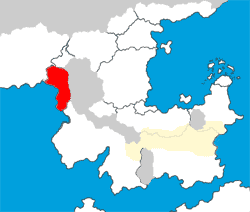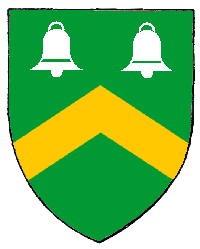Country Info: Bilgosh
 
Coat of arms of the Duchy of Bilgosh shown above. Emilian does not use this coat.
|
| Terminology: | Bilgosh (BEEL-gohsh) people, one Bilgoshman/Bilgoshwoman, many Bilgoshmen/Bilgoshwomen |
| Capital: | Desdovo (DEZ-doh-voh) |
| Monarch: | Emilian, the Overlord of Bilgosh |
| Coat of Arms: | (when humans ruled) Vert, a chevron or, in chief two churchbells argent. |
A land much like Southern Europe, Bilgosh is the source of many legends of the darker creatures -- werewolves, vampires, and the like. Perhaps because of this, its people, particularly the peasants, are very superstitious.
The land is pinned between an aggressive Zdunarovan empire to the north and a warlike Kiljuk Empire to the south. In the last few decades, the Bilgosh-Kiljukan border has crept ever more north as the Kiljuks have sent up waves of horsemen, eager to carve out provinces of their own and gain Bilgosh subjects.
In 1008, the human nobles and leaders of the country were slain in a two-week-long bloodbath. Stepping into their place were various Dark Lords: vampires, werewolves and necromancers, backed by their minions, who now ruled the land openly. They were led by Emilian, now the Overlord of Bilgosh.
History
The land we now call Bilgosh exists because of the hills that shelter it from the steppes to the north, and the edge of the Grendarr mountains. After the collapse of Sturia, Bilgosh was often the first point to be invaded by any Kislennic or Zdunarovan horde. Nomadic armies would rip across the steppe, some heading for modern-day Kislevia, others heading south to Bilgosh, only to emerge later in Kislevia. A few generations later, another group would do the same thing, driving out the leaders of the former conquerors of Bilgosh, but intermarrying with the populace.
The invasions settled down by about the year 600, and since then Bilgosh has only been conquered twice, most recently about two hundred years ago by a combined Zdunarovan and Kislevian army. The conquering nomad, Vasily I of Bilgosh, established the house of Charslavl as the rulers of Bilgosh. Unfortunately, he died without issue, and a civil war ensued. One side backed another nomadic general, Batak, but the winning side, made up mostly of Kislevian and Bilgosh soldiers, backed Duke Wladyslaw. Wladyslaw was a Bilgoshman in rebellion against the monarch before Vasily's forces arrived. Wladyslaw had allied himself to Vasily, and married a younger daughter (deceased without issue) of the Zdunarovan. Wladyslaw claimed a marital bond to the throne, Batak had only his soldiers, the people supported Wladyslaw (who was, after all, a Bilgoshman), and the war lasted only a few weeks.
Wladyslaw established a royal house that still rules over Bilgosh today - but found himself lacking the support to crown himself regent. Instead, he called himself the Grand Duke of Bilgosh, and took Dezdovo as his personal territory. He ruled Dezdovo, but the great nobles who backed the king in the civil war demanded almost complete autonomy over their regions. The Grand Duke could only press his will over the land if the Diet (made up of the fifty great landowners) vote in the majority for a measure. The Grand Duke can veto (non-overridable, but it risks rebellion), but not force legislation through. This means that Bilgosh is effectively a series of tiny autocracies, loosely bound together by the Duke, separated by wide tracts of still uncultivated forest and hills.
That said, Wladyslaw's heirs have worked hard to establish their permanent legitimacy as the only true rulers of Bilgosh, spreading fairly nasty rhetoric about Zdunarovans, Kislevians, and Kiljuks, hoping that through xenophobia there is strength! Relative to other national forces, the current Duke Milos' soldiers barely qualify as a national armed force. Combined with the soldiers of the other nobles, however, the natural defenses of Bilgosh make it possible to withstand attacks from both north and south. Still, the border creeps northward as the Kiljuk horsemen raid ever further northward. This is the current political situation of Bilgosh, relevant because the Grand Dukes have turned to trade as their one means of gaining needed revenue.
The Hesketines in the north and east tend to view Bilgosh as a superstitious uncultivated backwater -- well, those not in the know do, anyway. The more cosmopolitan Hesketines realize that the Bay of Dezdovo provides an important point for trade. Traders in furs and precious goods from across the steppe ride down the passes to the great city in the springtime, bringing the thick winter pelts in exchange for the benefits and silver of civilization. Kiljuks ride down with precious luxuries of Marakhin. Dwarven craftsmen find the trip to Dezdovo to be most congenial; it's hilly, if not mountainous, and they bring their wares in exchange for the good food and drink. Brave Marakh merchants conclude the western part of their route in Dezdovo Bay, bringing wares of Iñarra, Shenga, and the ancient fertile lands south of the Great Desert. In the springtime, when the icy grip of winter's darkness finally releases the frightened valleys of Bilgosh, there may be no other port in Hesket with a greater variety of goods, people, ideas, and entertainment.
Grand Duke Wladyslaw was no fool -- knowing he would never receive adequate tax revenue from the other nobles, he found a source of revenue for the Ducal Fisc in Dezdovo, and he and his heirs have done everything in their power to foster that trade over the years. What began as one day of celebration of Brinnig's ascendency over the night (taking place after the vernal equinox) has turned into a month of commerce and entertainment. People travel from all over Hesket not just to engage in trade, but to see the sights of this splendid city, partake in the exotic entertainments, moreover to pursue purposes best left undescribed..
War with Zdunarova
Zdunarova declared war on Bilgosh in 1003, claiming to possess papers ceding some lands if the Bilgoshmen fail to protect their subjects against "substantial acts of aggression by monstrous beasts". Zdunarova captured lands in the northwest of Bilgosh and besieged the Bilgosh capital in March 1004. It abandoned its siege a year later, in part due to rebellions in the Steinlands duchies. The two sides reached peace in February 1006, as Bilgosh ceded its two northwesternmost baronies.
Emilian's Rise
The death of Grand Duke Milos in 1007 led to a power vacuum in the country. His daughter Gordana was his heir, but the country (and ruling house) has been humiliated by the war, so Gordana's cousin Svetlana of Tragania proclaimed Milos and his issue unfit for rule, and she also claimed the ducal throne. Some nobles expressed reluctance to follow Gordana; some backed Svetlana. All over the country, soldiers and knights were called to arms.
Before hostilities could break out, however, Svetlana was murdered. Over the next two weeks, numerous nobles and officials were also found dead, many in grim ways. Panic swept the capital.
On June 5, 1008, the ducal palace rumbled. Emerging from Gordana's chambers was a vampire, who held Gordana's severed head in one hand and the ducal orb in the other. The vampire, Emilian, proclaimed himself Overlord of Bilgosh. Simultaneously, noble houses found similar deaths, their lieges slain and a new figure proclaiming itself Dark Lord or Dark Lady of the region.
Monarch
Emilian, the Overlord of Bilgosh; a powerful vampire.
Past Monarchs
- Vasily I - circa 600
- Wladyslaw - circa 800
- Milos II (b. 934) - circa 990 through 1007
- Gordana (b. 959) - 1007-1008
- Emilian - 1008-present
Nobles
Under human rule: ruled by a Grand Duke, with the standard noble a Baron.
Currently: various zones of the country are ruled by a Dark Lord or Dark Lady, who all answer to the Overlord. These Dark Lords are often vampires, but there are also werewolves and (mortal) necromancers.
